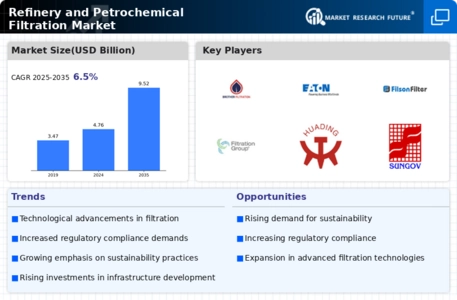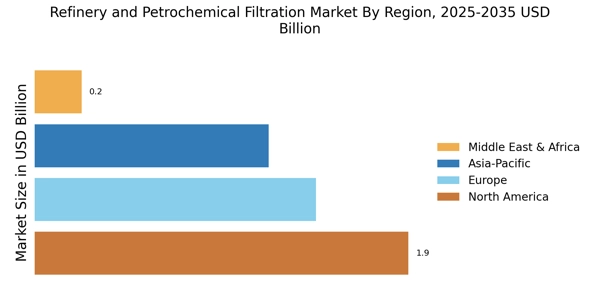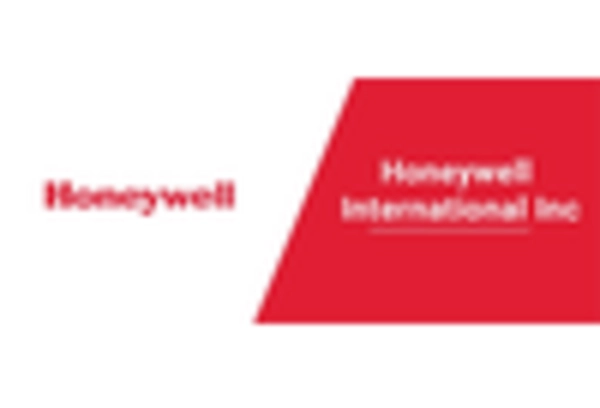Growing Focus on Water Management
Water management is increasingly becoming a focal point in the Refinery and Petrochemical Filtration Market. With water scarcity issues on the rise, refineries are prioritizing efficient water usage and treatment processes. The implementation of advanced filtration systems is essential for recycling and reusing water within refinery operations. In 2023, the market for water treatment technologies in the petrochemical sector was valued at approximately 30 billion USD, with expectations of continued growth. This emphasis on sustainable water management not only conserves resources but also reduces operational costs, thereby driving the demand for innovative filtration solutions. Consequently, the Refinery and Petrochemical Filtration Market is likely to benefit from this trend.
Increasing Demand for Clean Fuels
The rising demand for clean fuels is a pivotal driver in the Refinery and Petrochemical Filtration Market. As environmental regulations tighten, refineries are compelled to enhance their filtration processes to produce cleaner fuels. This shift is evident in the growing market for ultra-low sulfur diesel, which has seen a significant increase in production. In 2023, the market for clean fuels was valued at approximately 200 billion USD, with projections indicating a compound annual growth rate of 5% through 2028. Consequently, refineries are investing in advanced filtration technologies to meet these stringent requirements, thereby propelling the growth of the Refinery and Petrochemical Filtration Market.
Technological Advancements in Filtration Systems
Technological advancements play a crucial role in shaping the Refinery and Petrochemical Filtration Market. Innovations such as membrane filtration, nanofiltration, and advanced carbon filtration systems are becoming increasingly prevalent. These technologies not only enhance the efficiency of filtration processes but also reduce operational costs. For instance, the introduction of membrane bioreactors has revolutionized wastewater treatment in refineries, leading to a more sustainable approach. The market for advanced filtration technologies is expected to reach 15 billion USD by 2026, indicating a robust growth trajectory. As refineries adopt these cutting-edge solutions, the Refinery and Petrochemical Filtration Market is likely to experience substantial expansion.
Regulatory Compliance and Environmental Standards
Regulatory compliance is a significant driver influencing the Refinery and Petrochemical Filtration Market. Governments worldwide are implementing stringent environmental standards to mitigate pollution and protect natural resources. Refineries must adhere to these regulations, which often necessitate the adoption of advanced filtration systems to minimize emissions and effluents. In 2023, the market for environmental compliance technologies was estimated at 50 billion USD, with a projected growth rate of 6% annually. This regulatory landscape compels refineries to invest in filtration solutions that not only meet compliance but also enhance operational efficiency. As a result, the Refinery and Petrochemical Filtration Market is poised for growth as refineries seek to align with these evolving standards.
Rising Investment in Petrochemical Infrastructure
The rising investment in petrochemical infrastructure is a key driver for the Refinery and Petrochemical Filtration Market. As countries seek to bolster their energy security and economic growth, significant capital is being allocated to the development of new refineries and the expansion of existing facilities. In 2023, investments in petrochemical infrastructure reached approximately 100 billion USD, with projections indicating sustained growth in the coming years. This influx of capital is likely to lead to increased demand for advanced filtration systems, as new facilities require state-of-the-art technologies to ensure efficient and compliant operations. Thus, the Refinery and Petrochemical Filtration Market stands to gain from this trend as investments continue to flow into the sector.


















Leave a Comment